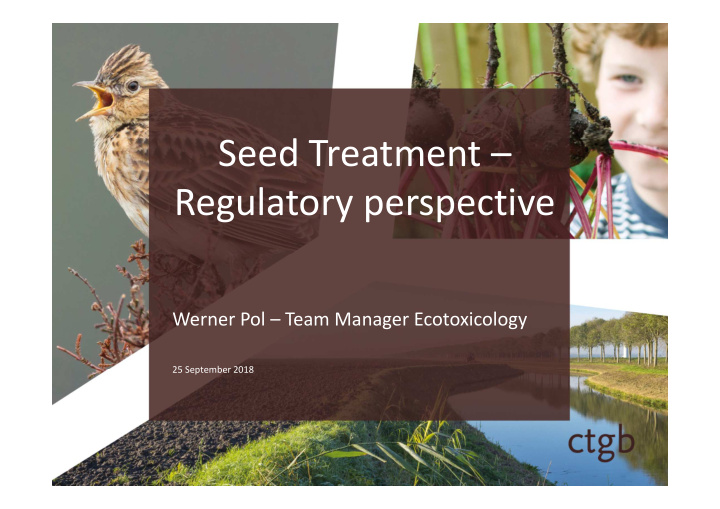



Seed Treatment – Regulatory perspective Werner Pol – Team Manager Ecotoxicology 25 September 2018
Content • Introduction • Ctgb • Regulatory framework • Risk assessment environment according to Guidance Document • Harmonisation 2
Introduction � 2008 start discussion dust drift in relation to bee mortality � 2010 first measures for seed sowing machines (deflectors) on label 3
Ctgb - General data Secretariat • In house experts for all aspects • 165 staff (77 fte in 2011 and 150 fte now) • hourly fee € 132,- (2018) • budget: ca. € 18.900.000 • 75% income based on fees for applications • 15% based on a yearly fixed fee per authorised product • 10% related to requests for advice from ministries 4
Ctgb - Organisational Chart 5
Environment Ctgb Ministries LNV, I&W, VWS, SZW Board of the authorisation of plant Producer User protection products and biocides NGO’s and consumer organisations 6
Regulation (EU) No 1107/2009 Placing treated Authorisation seeds on the of PPP market Labelling Zonal system Free for evaluation movement of seeds Protective measures 7
Treatment of seeds Art. 28: Authorisation and placing on the market and use • A national authorisation is required to treat seeds • Treated seeds are not considered as plant protection products 8
Placing on the market, Art. 49 Art. 49: Placing on the market and use • Free movement of treated seeds • Protective measures • Labelling of treated seeds 9
Placing on the market, Art. 49 (1) Free movement of treated seeds: ‘ Member States shall not prohibit placing on the market and use of seeds treated with plant protection products authorised for that use in at least one Member State ’ 10
Protective measures, Art. 49 (2) • Substantial concerns: serious risk to human or animal health or to the environment • Measures to restrict or prohibit the use and/or sales of such treated seeds (Regulatory procedure) 11
Labelling of treated seeds, Art 49 (4) Label and documents accompanying treated seeds shall include: • Name of PPP with which the seeds were treated • Name of active substance(s) in that product • Standard phrases for safety precautions • Risk mitigation measures set out in the authorisation 12
Evaluation of application Art. 33.2 (b) “..for seed treatment, only one Member State shall be proposed, which evaluates the application taking account of all zones.” 13
Differences between MS • Sowing practice • Climatic conditions • Dissipation/degradation in environmental compartments • Available risk mitigation measures • Ecology 14
Dust drift deposition • Exposure based on seed quality • No informaIon → reference values or worst case assumptions 15
Dossier content In addition to general data requirements: • Heubach values including a.s. content in dust • Residue analytical methods for all concerned MS • Agricultural practice in all concerned MS – Sowing density – Machinery – Available risk mitigation measures • Tests with A. rhopalosiphi and T. pyri (case by case) 16
Risk assessment environment • Agreed GD to be used when available • GD particularly considers: - risk aquatic organisms due to dust drift - risk to bees and non-target arthropods due to dust drift Fine tuned assessment for acute contact dust exposure 17
GD Seed Treatment Scopaff July 2018: - Seed Treatment Draft GD in consultation. - Next WG in October to discuss comments. - Export to third world countries described in § 2.3 (Not allowed under 1107.) 18
Risk assessment non targets organisms 19
Ctgb and Harmonisation • Ctgb organises workshops → Guidance e.g.: New EPPO standard “principles of efficacy evaluation for low-risk plant protection products” • Evaluation Manual available • Ctgb in discussions with EFSA on assessment micro-organisms • Green: Ctgb keeps obstacles as low as possible (low efficacy) 20
Positive take-aways • GD seed treatment finalised soon • Updated risk assessment for bees • Information on seed quality is key • Better harmonisation of the risk assessment for seed treatments is foreseen 21
Further Considerations Authorisation will not become easier Applicant is responsible for application - Ctgb can only assess the information provided Higher tier assessments left open to MS level • especially ecological refinements and risk mitigation →→ MS level 22
Thank you for your attention ! 23
Recommend
More recommend